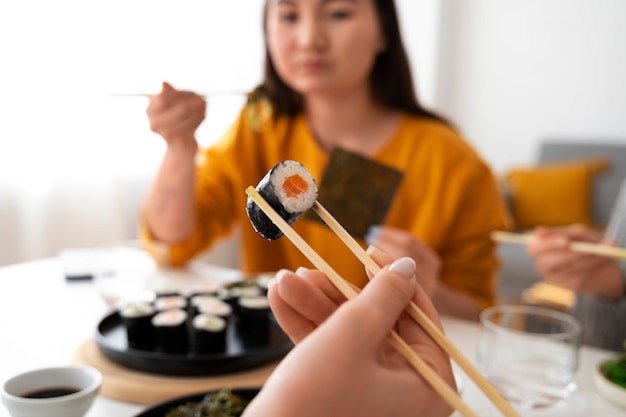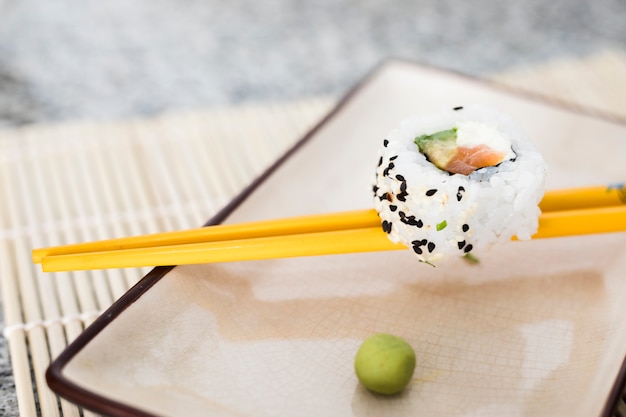Let's be honest, sushi rice is the heart and soul of any good sushi roll. It's the foundation on which everything else is built. Without that perfect, sticky, and slightly tangy rice, your sushi just won't be the same. It's not just about the taste; it's about the texture, the way it holds together, and the way it complements the other flavours. And that's what I'm going to help you achieve with this sushi rice masterclass.
I've been making sushi for years, and I've learned a thing or two about getting that perfect rice. I've experimented with different techniques, read countless articles, and even had some epic fails along the way. But I'm here to tell you, it's not as daunting as it might seem. It's a simple process, and once you've mastered it, you'll be making sushi like a pro.
So grab your favourite tea, get comfy, and let's dive into the world of sushi rice. We'll cover everything you need to know to make sushi rice that's consistently perfect, from choosing the right rice to the final step of seasoning and cooling. By the end of this, you'll be a sushi rice master.
(Part 1) Rice is King: Choosing the Right Kind

The first step on our sushi rice journey is choosing the right rice. You see, not all rice is created equal, especially when it comes to sushi. We're talking about short-grain japanese rice, a type that's all about that sticky texture we crave. It's what gives sushi that unique bite and allows it to hold its shape when you roll it.
You might see it labelled as "sushi rice," "japonica rice," or even "short-grain Japanese rice." But here's the thing, it's not just about the label. It's about the quality of the rice. The best sushi rice is freshly milled, has a bright white colour, and feels firm to the touch.
Top Tips for Choosing Sushi Rice
- Check the label: Always look for "sushi rice," "japonica rice," or "short-grain Japanese rice." You can also try Nihonbare or Koshihikari, but be prepared to adjust your cooking time and water ratio slightly.
- Read the reviews: Before you buy, take a look at the reviews from other sushi-loving folks. They can give you valuable insights into the quality and stickiness of the rice.
- Buy from a reputable source: You want rice that's fresh and high quality. Head to your local Asian grocery store or a reputable online retailer.
- Look for the date: Check the milling date on the package. The fresher the rice, the better.
- Feel the rice: If you can, feel the rice grains. They should be firm and not overly soft.
(Part 2) Rinse and Repeat: Washing the Rice

Now that you've got your rice, it's time to give it a good wash. This step is essential, as it removes excess starch, which can make the rice gummy. And trust me, no one wants gummy sushi.
Washing the rice is a simple process, but it's one that requires a bit of attention. You want to rinse the rice until the water runs clear, which means you'll be doing a lot of rinsing!
The Washing Process
- Measure out your rice: Use the measuring cup that came with your rice cooker or measure out the amount you need in a bowl.
- Rinse the rice: Pour the rice into a fine-mesh strainer and rinse it under cold running water until the water runs clear. Don't be afraid to give it a good scrub with your fingers. You're essentially removing any loose starch and impurities.
- Drain the rice: Let the rice drain in the strainer for a few minutes, then transfer it to a clean bowl.
You might be thinking, "Why do we need to wash the rice?" Well, it's all about those starch granules. They're what give rice its stickiness, and while we want sticky rice for sushi, we don't want it to be overly sticky. Washing the rice helps remove the excess starch, resulting in a rice that holds together without being a sticky mess.
(Part 3) Soaking Secrets: A Step for Super Sticky Rice

Now, here's a little secret that I've learned over the years: soaking the rice. Soaking the rice before cooking allows it to absorb moisture evenly, resulting in a more consistent texture and a slightly stickier rice. It might seem like an extra step, but it's worth it for that perfect sushi rice.
How to Soak Your Rice
- Soak the rice: After washing the rice, transfer it to a clean bowl, add cold water, and let it soak for 30 minutes. The water should be about an inch above the level of the rice.
- Drain the rice: After 30 minutes, drain the rice and transfer it back to the bowl.
Soaking isn't mandatory, but it's a trick I swear by. It's a simple step that can make a big difference in the texture of your sushi rice. It allows the rice to absorb moisture more evenly, making it stickier and more cohesive. You'll notice the difference in the final product.
(Part 4) Cooking Time: The Art of the Perfect Boil
Now, we're getting to the heart of the matter: cooking the rice. This is where you need to pay attention, as the cooking time and water ratio are crucial. I've tried different methods over the years, from using a rice cooker to a simple pot on the stove. But I've found that a simple pot on the stove is the most reliable way to cook sushi rice for a consistently perfect result.
The Stovetop Method
- Prepare the pot: Choose a medium-sized pot with a tight-fitting lid. Add the rice to the pot and add water. You want to use a ratio of 1:1.2 water to rice. This means, for 1 cup of rice, you'll use 1.2 cups of water.
- Bring the water to a boil: Place the pot on the stove over high heat and bring the water to a boil. Once the water is boiling, reduce the heat to low and cover the pot with the lid.
- Simmer the rice: Let the rice simmer gently for 15 minutes. You want the rice to absorb all the water and become tender. Don't lift the lid during this time, as you want to maintain the steam and ensure even cooking.
- Rest the rice: After 15 minutes, remove the pot from the heat and let the rice rest, covered, for another 10 minutes. This allows the rice to continue to absorb moisture and become even more tender.
Don't be tempted to lift the lid during the simmering and resting time. It's important to keep the heat trapped inside so that the rice cooks evenly. You'll also want to make sure that the rice doesn't stick to the bottom of the pot, so use a pot with a non-stick coating or line the bottom with parchment paper.
And remember, every stove is different, so adjust the heat accordingly. You want a gentle simmer, not a rolling boil. You'll know the rice is cooked when it's tender and the water is absorbed.
(Part 5) The Seasoning Touch: The Key to Delicious Sushi Rice
Now, the rice is cooked, but it's not quite ready for sushi yet. It needs a little seasoning magic to bring out its full flavour. This is where it gets fun, and where you can add your own personal touch!
We'll be adding two key ingredients: rice vinegar and sugar. These two ingredients work together to create that classic tangy, slightly sweet flavour that we love in sushi rice. And the best part is that you can adjust the seasoning blend to your liking.
The Seasoning Blend
Here's the basic seasoning blend I use for my sushi rice. Feel free to adjust it to your liking:
| Ingredient | Amount |
|---|---|
| Rice vinegar | 1/4 cup |
| Sugar | 2 tablespoons |
| Salt | 1/2 teaspoon |
Some people like a more vinegary flavour, while others prefer a sweeter rice. Experiment and find what you like best! You can also add a pinch of mirin (sweet rice wine) to the seasoning blend for a touch of sweetness and depth of flavour.
The Seasoning Process
- Prepare the rice: Once the rice has rested for 10 minutes, transfer it to a large bowl.
- Combine the seasoning: In a small saucepan, combine the rice vinegar, sugar, and salt. Heat the mixture over low heat, stirring constantly, until the sugar dissolves. Let it cool slightly.
- Season the rice: Pour the cooled vinegar mixture over the rice and gently fold it in with a rice paddle or a wooden spoon. Don't overmix, as you want to maintain the fluffiness of the rice.
- Spread the rice: Spread the seasoned rice evenly in a shallow dish or tray to cool. This allows the rice to cool quickly and evenly. You want the rice to be room temperature before you use it for sushi.
The key is to season the rice evenly and gently. The rice vinegar gives the rice a tangy flavour, the sugar balances out the acidity, and the salt adds a touch of umami. This seasoning blend adds a whole new dimension to the rice, making it the perfect base for your sushi.
(Part 6) Cooling Down: The Secret to a Perfect Bite
You've got your perfectly seasoned sushi rice, but don't rush into making your rolls just yet. You need to let the rice cool down to room temperature. This step is crucial for a couple of reasons.
Why Cooling is Essential
- Prevents stickiness: When the rice is hot, it's more prone to sticking together, resulting in a gummy mess. Cooling it down helps to firm up the rice grains, making them less sticky and easier to handle.
- Enhances flavour: Cooling the rice allows the flavours of the seasoning to fully develop, creating a more complex and balanced taste. You'll notice the difference when you bite into that sushi roll.
- Improves texture: Cooling the rice allows the grains to firm up, creating a better texture that's easier to work with.
Tips for Cooling Your Rice
- Spread it out: Spread the rice evenly in a shallow dish or tray. This allows the rice to cool quickly and evenly.
- Fan it out: Use a fan or a hairdryer on a cool setting to speed up the cooling process. This is especially helpful in humid weather.
- Patience is key: Don't rush the cooling process. It takes about 30 minutes for the rice to cool down to room temperature. Be patient, and your rice will be perfectly ready for sushi making.
You'll know the rice is ready when it's cool to the touch. Don't worry, it's a crucial step, and it's a much better experience when you take your time and let the rice cool down properly. The rice will be less sticky, easier to work with, and it'll taste even better.
(Part 7) The Sushi Rice Commandments: Essential Tips
Alright, you've got your perfectly seasoned and cooled sushi rice. You're ready to roll, literally! But before you get started, here are a few essential tips to keep in mind. These are the golden rules of sushi rice, and they'll ensure your sushi rolls are a success.
The Golden Rules of Sushi Rice
- Use your hands: When handling sushi rice, use your hands, not a spoon. This will help you to gently shape the rice without crushing it. It also allows you to feel the texture of the rice and make sure it's not too sticky or dry.
- Moisten your hands: Keep your hands slightly moistened with water to prevent the rice from sticking to them. It's a simple trick that makes a big difference.
- Don't overpack the rice: When making sushi rolls, don't overpack the rice. It should be firm, but not dense. You want to be able to bite through the roll without feeling like you're chewing on a brick.
- Store it properly: Leftover sushi rice can be stored in an airtight container in the refrigerator for up to 3 days. Just make sure it's completely cooled before storing it.
These tips might seem simple, but they're essential for making sushi rice that's delicious and enjoyable. You'll be able to create sushi rolls that are light, flavorful, and satisfying.
(Part 8) Sushi Rice Masterclass: A Wrap Up
So there you have it! You've just completed your sushi rice masterclass. With a little practice and these simple tips, you'll be able to create sushi rice that's perfect every time. You'll be able to impress your friends and family with your culinary skills.
And remember, sushi making is all about experimentation and having fun. Don't be afraid to try new things and create your own unique sushi rolls. The possibilities are endless!
FAQs
1. Can I use regular rice for sushi?
While you can technically use regular rice, it won't have the same sticky texture as short-grain Japanese rice. The high starch content in short-grain rice is essential for creating that cohesive, bite-sized texture that sushi is known for. It's what allows the sushi to hold its shape and prevent it from falling apart.
2. Why does my sushi rice stick together?
If your sushi rice is too sticky, it could be due to several factors:
- Over-washing: Washing the rice too much can remove too much starch, leading to a gummy texture. Stick to rinsing the rice until the water runs clear, and don't over-scrub it.
- Insufficient soaking: Soaking the rice helps it absorb moisture evenly, preventing stickiness. Try soaking the rice for 30 minutes before cooking.
- Overcooked rice: Overcooking the rice can also make it stickier. Make sure you follow the cooking time and don't lift the lid during the cooking process.
- Too much vinegar: If you use too much rice vinegar, it can make the rice too wet and sticky. Start with the basic seasoning blend and adjust it to your liking.
3. How can I make my sushi rice less sticky?
If you find your sushi rice is too sticky, you can try the following tips:
- Reduce the washing time: Rinse the rice for a shorter period, just until the water runs clear.
- Skip soaking: You can skip the soaking step if you're having issues with stickiness.
- Adjust the water ratio: Try using less water when cooking the rice.
- Reduce the vinegar: Use slightly less rice vinegar when seasoning the rice.
- Add more sugar: Adding a bit more sugar to the seasoning blend can help balance out the acidity and reduce the stickiness.
4. What are some common sushi rice mistakes?
Here are some common mistakes to avoid when making sushi rice:
- Using the wrong type of rice: Make sure you use short-grain Japanese rice for the best results. Don't try to use regular long-grain rice, as it won't have the same texture.
- Not washing the rice: Washing the rice removes excess starch, which can make the rice gummy. It's a crucial step for getting that perfect texture.
- Over-cooking the rice: Overcooked rice will be too soft and sticky. Follow the cooking time carefully and don't lift the lid during the cooking process.
- Not seasoning the rice: Seasoning the rice is crucial for enhancing its flavor and creating that classic sushi taste. The rice vinegar, sugar, and salt work together to create a unique and delicious flavour.
- Not cooling the rice: Cooling the rice allows it to firm up and prevents it from becoming too sticky. It also allows the flavours of the seasoning to develop fully.
5. What are some creative ways to use leftover sushi rice?
Don't throw away leftover sushi rice! It can be used in various delicious ways:
- Sushi rice salad: Combine leftover sushi rice with your favorite vegetables, protein, and a tangy dressing for a refreshing salad. Try adding edamame, cucumber, avocado, and a light sesame dressing.
- Sushi rice fritters: Mix leftover sushi rice with eggs, vegetables, and your choice of seasonings, then fry them into crispy fritters. Add some chopped scallions, carrots, and a touch of ginger for a flavorful fritter.
- Sushi rice balls: Form leftover sushi rice into bite-sized balls and serve them with soy sauce, wasabi, and pickled ginger. You can also add a filling, such as salmon, tuna, or avocado.
- Sushi rice soup: Add leftover sushi rice to a miso soup or other soup recipe for a unique twist. The rice adds a bit of texture and a subtle sweetness to the soup.
- Sushi rice pudding: Use leftover sushi rice to make a unique and flavorful rice pudding. Add milk, sugar, cinnamon, and a pinch of salt, then bake it in the oven.
Everyone is watching

How to Cook Frozen Lobster Tails Perfectly: A Step-by-Step Guide
RecipesLobster. Just the word conjures up images of lavish meals, special occasions, and a taste of luxury. But let's...

Pork Fillet Cooking Time: How Long to Cook It Perfectly
RecipesPork fillet, or tenderloin as it's sometimes called, is a real favourite in our house. It's so versatile, and...

Pigs in a Blanket Cooking Time: How Long to Bake for Perfect Results
RecipesAh, pigs in a blanket. Just the name conjures up images of those delightful little parcels of crispy pastry en...

The Ultimate Guide to Cooking Delicious Frankfurters
RecipesLet's face it, we all love a good frankfurter. It's a classic, simple, and always satisfying. But let's be rea...

Wolf Meat Recipes: A Guide to Cooking Wild Game
RecipesLet's be honest, you don't see wolf meat at your local butcher shop every day. It's a bit of a wild card, but ...
